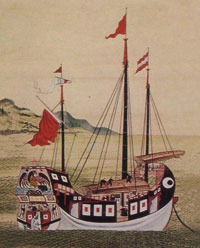| Discovering Asia's
ceramic development |
Summary
 Shipwreck
cargos are good indicators of trade items available at the time of the last
voyage, although not necessarily including all goods available. Merchants would
have selected products appropriate to the route, and on commercial criteria.
Shipwreck
cargos are good indicators of trade items available at the time of the last
voyage, although not necessarily including all goods available. Merchants would
have selected products appropriate to the route, and on commercial criteria.
The cargo of the seven shipwrecks displayed here shows that Thai and Vietnamese
kilns challenged the early Chinese monopoly of ceramic exports from the late
14th century to the mid 16th century. The established indigenous potteries at
Sisatchanalai appear to have started production of underglaze black decorated
ware under foreign influence. Nearby Sukhothai started producing at around this
time, and may have been the first to export such products. The later introduction
of celadon at Sisatchanalai seems to have been influenced by a second infusion
of know-how.
Sisatchanalai and Sukhothai continued to produce plates and other products
for the next two hundred years. Sisatchanalai soon overtook the early export
dominance of Sukhothai. Underglaze decorated and celadon plates seem to have
been the main product until the mid 16th century. After this, the Sisatchanalai
kilns seem to have reverted to underglaze production, although using different
clay, forms and motifs. Sukhothai switched from plates to bowls with a new decorative
style.
By the late 16th century, the Thai kilns ceased production, except at Singburi.
Chinese blue-and-white had become immensely popular in both Southeast Asian
and European markets. None of the Southeast Asian kilns could compete. After
two hundred years, China again dominated Asia's ceramic trade.
Miscellany
The wrecks have shed light on the technology, money, meals
and beauty products of centuries gone by. Please read
on!
Items for sale
Following the completion of excavations, research, recording of all artefacts,
and reports, Nanhai Marine Archaeology Sdn. Bhd. shares the recoveries with
the National Museum, which maintains its share for continued study and display.
Nanhai Marine Archaeology is allowed to sell its share to finance further work.
It is the policy of the company to donate other artefacts to relevant museums,
present the findings from the excavations and research to the widest possible
audience, and then to sell the remaining pieces. If interested in owning one
of these historical objects, please see the company's website, www.mingwrecks.com,
or contact Sten Sjostrand.
 Shipwreck
cargos are good indicators of trade items available at the time of the last
voyage, although not necessarily including all goods available. Merchants would
have selected products appropriate to the route, and on commercial criteria.
Shipwreck
cargos are good indicators of trade items available at the time of the last
voyage, although not necessarily including all goods available. Merchants would
have selected products appropriate to the route, and on commercial criteria.